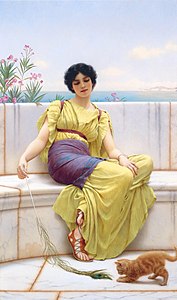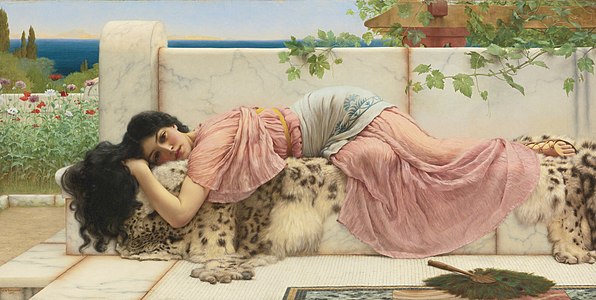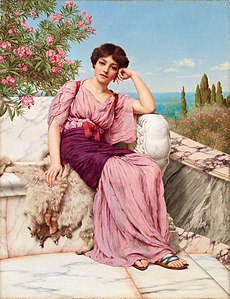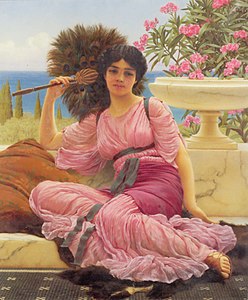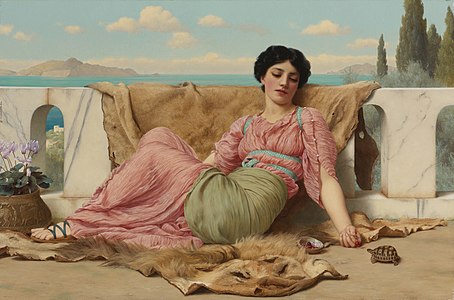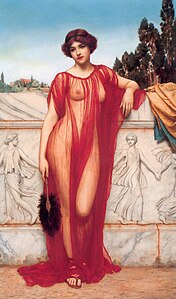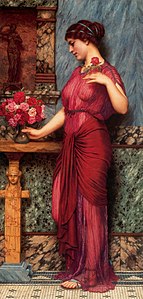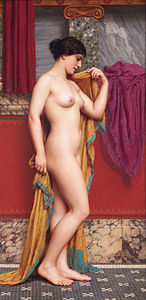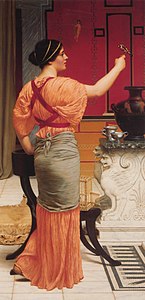John William Godward
John William Godward | |
|---|---|
Academism | |
| Patron(s) | Lawrence Alma-Tadema |
John William Godward (9 August 1861 – 13 December 1922) was an English painter from the end of the
Early life
Godward was born in 1861 and lived in Wilton Grove, Wimbledon. He was born to Sarah Eboral and John Godward (an investment clerk at the Law Life Assurance Society, London).[1]: 17–19 He was the eldest of five children. He was named after his father John and grandfather William. He was christened at St Mary's Church, Battersea on 17 October 1861. The overbearing attitude of his parents made him reclusive and shy later in adulthood.[1]: 22
Career
He exhibited at the
One of his best-known paintings is Dolce far Niente (1904), which was purchased for the collection of Andrew Lloyd Webber in 1995. As in the case of several other paintings, Godward painted more than one version; in this case, an earlier (and less well-known) 1897 version with a further 1906 version.[3]
He committed suicide at the age of 61 and is said to have written in his suicide note that "the world is not big enough for [both] myself and a Picasso".[4][unreliable source?]
His estranged family, who had disapproved of his becoming an artist, were ashamed of his suicide and burned his papers. Only one photograph of Godward is known to survive.[5]
Works
Godward was a Victorian Neo-Classicist, and therefore, in theory, a follower of Frederic Leighton. However, he is more closely allied stylistically to Sir Lawrence Alma-Tadema, with whom he shared a penchant for the rendering of Classical architecture – in particular, static landscape features constructed from marble.
The vast majority of Godward's extant images feature women in Classical dress posed against landscape features, although there are some semi-nude and fully nude figures included in his oeuvre, a notable example being In The Tepidarium (1913), a title shared with a controversial
Given that Classical scholarship was more widespread among the potential audience for his paintings during his lifetime than in the present day, meticulous research of detail was important in order to attain a standing as an artist in this genre. Alma-Tadema was an
In addition, Godward painstakingly and meticulously rendered other important features in his paintings, animal skins (the paintings Noon Day Rest (1910) and A Cool Retreat (1910) contains examples of such rendition) and wildflowers (Nerissa (1906) and Summer Flowers (1903) are again examples of this).
The appearance of beautiful women in studied poses
Godward "quickly established a reputation for his paintings of young women in a classical setting and his ability to convey with sensitivity and technical mastery the feel of contrasting textures, flesh, marble, fur and fabrics."[1]: 91 Godward's penchant for creating works of art set in the classical period probably came from the time period in which he was born. "The last full-scale classical revival in western painting bloomed in England in the 1860s and flowered there for the next three decades."[7]
Gallery
- John William Godward's works
-
Far Away Thoughts, 1892
-
Idle Moments, 1895
-
The Signal, 1899
-
Idleness, 1900
-
The Jewel Casket, 1900
-
Youth and Time, 1901
-
With Violets Wreathed and Robe of Saffron Hue, 1902
-
When the heart is young, 1902
-
Summer Flowers, 1903
-
The Old Old Story, 1903
-
In the Days of Sappho, 1904
-
Dolce far Niente, 1904
-
Sweet Dreams, 1904
-
Flabellifera, 1905
-
The quiet pet, 1906
-
Violets, sweet violets, 1908
-
A Classical Beauty
- Standing poses
-
A Pompeian Bath, 1890
-
A Priestess 2 1893
-
A Priestess, 1894
-
He Loves Me, He Loves Me Not, 1896
-
Venus Binding Her Hair, 1897
-
Idle Thoughts, 1898
-
The Mirror, 1899
-
Nerissa (1906)
-
The Tambourine Girl, 1906
-
Drusilla, 1906
-
Athenais, 1908
-
An Offering to Venus, 1912
-
In the Tepidarium, 1913
-
A fair reflection, 1915
-
Lesbia with the Sparrow, 1916
-
At the Window, 1920
List of works by the artist
|
This list is not a complete list but serves to illustrate the extent of Godward's output. |
References
- ^ ISBN 978-1-85149-270-1.
- ^ a b Barrow, Rosemary (2011), "Godward, John William (1861–1922)", Oxford Dictionary of National Biography (online ed.), Oxford University Press, retrieved 23 August 2015 (subscription or UK public library membership required)
- ^ "John William Godward, R.B.A." Sothebys. Archived from the original on 24 September 2015. Retrieved 23 August 2015.
- ^ "John William Godward". Heritage Auctions. Retrieved 23 August 2015.
- ISBN 978-1851499038.
- ^ Calinski, Tobias. Catull in Bild und Ton (2021). Darmstadt: WBG. 158-183
- ^ Gaines, Charles (1985). "Art: Those Victorian Ladies". Architectural Digest. 42: 125.
- ^ "Godward, john william, r.b.a. At ||| figures ||| sotheby's l18133lot9zj5sen". Archived from the original on 15 December 2018. Retrieved 11 December 2018.




